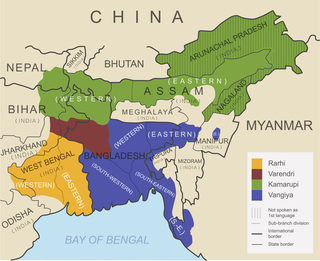Related Research Articles
Most languages of Europe belong to the Indo-European language family. Out of a total population of 744 million, some 94% are native speakers of an Indo-European language; within Indo-European, the three largest phyla are Romance, Germanic, and Slavic with more than 200 million speakers each, between them accounting for close to 90% of Europeans. Smaller phyla of Indo-European found in Europe include Hellenic, Baltic, Albanian, Indo-Aryan, and Celtic.
Ethnologue: Languages of the World is an annual reference publication in print and online that provides statistics and other information on the living languages of the world. It was first issued in 1951, and is now published annually by SIL International, a U.S.-based, worldwide, Christian non-profit organization. SIL's main purpose is to study, develop and document languages to promote literacy and for religious purposes.

Makhuwa is the primary Bantu language of northern Mozambique. It is spoken by 4 million Makua people, who live north of the Zambezi River, particularly in Nampula Province, which is virtually entirely ethnically Makua. It is the most widely spoken indigenous language of Mozambique.
Luhya is a Bantu language of western Kenya.

Chittagonian is an Indo-Aryan language spoken in the Chittagong Division in Bangladesh. It is often erroneously considered to be a nonstandard dialect of Bengali, although the two are not mutually intelligible. It is estimated (2009) that Chittagonian has 13–16 million speakers, principally in Bangladesh.
Wetarese is an Austronesian language of Wetar, an island in the south Maluku, Indonesia, and of the nearby islands Liran and Atauro, the latter in East Timor north of Dili. The four principal varieties of Wetarese on Wetar are distinct enough they may be considered different languages.
The Tharu or Tharuhat languages are any of the Indo-Aryan languages spoken by the Tharu people of the Terai region in Nepal, and neighboring regions of Uttarakhand, Uttar Pradesh and Bihar in India.

Sámi languages, in English also rendered as Sami and Saami, are a group of Uralic languages spoken by the Sámi people in Northern Europe. There are, depending on the nature and terms of division, ten or more Sami languages. Several spellings have been used for the Sámi languages, including Sámi, Sami, Saami, Saame, Sámic, Samic and Saamic, as well as the exonyms Lappish and Lappic. The last two, along with the term Lapp, are now often considered pejorative.
Mijikenda is a Bantu dialect cluster spoken along the coast of East Africa, mostly in Kenya, where there are 1.9 million speakers but also in Tanzania, where there are 100,000 speakers. The name Mijikenda means "the nine settlements" or "the nine communities" and refers to the multiple language communities that make up the group. An older, derogatory term for the group is Nyika which refers to the "dry and bushy country" along the coast.
Grand Valley Dani, or simply Dani, is one of the most populous Papuan languages in Indonesian New Guinea. The Dani people live in the Baliem Valley of the Western Highlands.
Luyana (Luyaana), also known as Luyi, is a Bantu language spoken in Zambia and perhaps in small numbers in neighboring countries. It appears to be an divergent lineage of Bantu. It is spoken by the Luyana people, a subgroup of the Lozi people.
Zemba (Dhimba) is a Bantu language spoken mainly in Angola where the language has about 18,000 speakers, and also in Namibia with some 4,000. It is closely related to Herero, and is often considered a dialect of that language, especially as the Zemba are ethnically Herero.
Buyu, or Buyi, is a Bantu language of Lake Tanganyika that is closely related to Nyanga.
Kayan is a dialect cluster spoken by the Kayan people of Borneo. It is a cluster of closely related dialects with limited mutual intelligibility, and is itself part of the Kayan-Murik group of Austronesian languages.
Lamaholot, also known as Solor or Solorese, is a Central Malayo-Polynesian dialect cluster of Flores, Indonesia. The varieties may not be all mutually intelligible; Keraf (1978) reports that there are 18 languages under the name.
Spurious languages are languages that have been reported as existing in reputable works, while other research has reported that the language in question did not exist. Some spurious languages have been proven to not exist. Others have very little evidence supporting their existence, and have been dismissed in later scholarship. Others still are of uncertain existence due to limited research.

The Bengali–Assamese languages belong to the Eastern zone of Indo-Aryan languages. They are the following:
References
- ↑ Papasena at Ethnologue (18th ed., 2015)
- ↑ Hammarström, Harald; Forkel, Robert; Haspelmath, Martin, eds. (2017). "Papasena". Glottolog 3.0 . Jena, Germany: Max Planck Institute for the Science of Human History.
| This Indonesia-related article is a stub. You can help Wikipedia by expanding it. |
| This Papuan languages-related article is a stub. You can help Wikipedia by expanding it. |